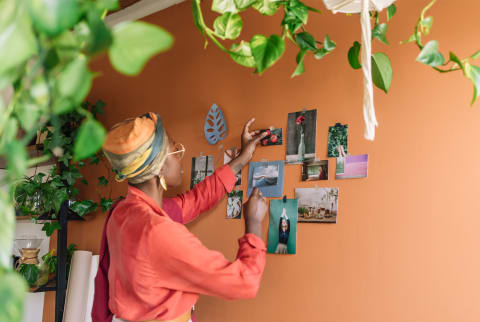Advertisement
How A Neuroscientist Creates A Vision Board + A Trick To Make It Even More Effective


Not everyone loves to exercise or eat healthy food, but enhanced longevity and better energy (plus a load of other health benefits) are reason enough to make those activities stick. On a similar note, personal growth practices can also feel mundane, but for a healthy brain (and, thus, a happier you), it's generally worth it.
However, one mental health practice often feels personally enjoyable, even comparable to an art project (just, you know, with way more brain-building benefits): We're talking about vision boards. And as neuroscientist and author of The Source Tara Swart, M.D., Ph.D., explains on the mindbodygreen podcast, you can make any vision board even more effective with this easy switch.
How vision boards work
Based on the principles of the law of attraction, a vision board is essentially a collection of images, quotes, and other objects that serve as visual representations of your goals.
You can make a vision board out of magazine and photo cutouts, or you can opt for a digital vision board and print it out for less waste. The process is broken down in this story, but here's a quick overview:
- Get clear on your intention. Start by asking yourself, What do I want to invite/manifest into my life? It can be a physical thing (perhaps your goal is to buy a house), a personality trait (positivity, motivation, for example), etc.
- Zero in on your images and objects. Once you're clear on how you'd like to use your vision board, you can home in on some images and objects that represent your goals. These could be magazine clippings, photos—really anything that resonates with you.
- Start arranging. This is the fun part! Begin arranging and rearranging your board with the images you gathered. Move things around until you feel inspired when you look at it. It's best not to glue anything down until you have your layout established. The most important thing is simply to have fun with the process and take your time with it.
- Find a place for it. Once you're pleased with the final product, find a place to put your board where it can provide daily inspiration, like on an altar or your nightstand (more on placement to come).
Why they work
"We're bombarded with so much information," Swart says. "This has been the case for a long time, but if you read a copy of the New York Times today, you would receive as much information from that one newspaper as somebody would in their entire lifetime 100 years ago, and even then, they were overly bombarded with information," she adds.
Vision boards help your brain sift through that information and home in on exactly what it is that you want. Your brain's natural filtering mechanism ensures that you don’t notice things that aren't relevant to your survival; however, in modern times, you may actually need to pay closer attention to those stimuli.
The next mechanism, Swart explains, is selective attention, which means that you start to notice things in your daily life that you already have on your vision board. "It's like when you buy a new car, and you suddenly see it everywhere," she says. "It's basically priming your brain to notice opportunities that will take you closer to your goals."
Finally, you have value tagging. The brain does this in two ways, Swart says, including a cold or logical way and in a warm or emotional way. Your survival necessities fall into the logical tagging, while more emotional things (like those on your vision board) fall into the latter tagging.
"By repeatedly exposing your brain to these images, you're priming it to not just notice but also grasp the opportunities that will take you closer to what you want," she says. "That's why I call vision boards 'action boards' because I don't believe that you can create this fantasy image and sit at home and wait for it to come true," she adds. "I believe that you need to be out there networking, dating, whatever it is, to get the things that you want."
A trick to make them even more effective
However, one quick hack can level up the efficacy of your vision board: Look at it before you fall asleep.
"There's a psychological phenomenon called the Tetris effect1, which says that the thing you look at last imprints on your subconscious more strongly than anything else during the day," Swart explains. "So, I keep my physical action board next to my bed so that I see it first thing in the morning and at night."
When the body goes from a sleep state to a waking state (or vice versa), the body kicks into what's known as the hypnopompic and hypnagogic stages. "They are stages where our subconscious is very susceptible to suggestion," Swart says. So, long story short: Let your vision board be the last thing you look at before bed and the first thing you look at when you wake up.
The takeaway
Creating a vision board can serve as a fun craft and a meaningful task in the long run. As Swart explains, vision boards help your brain sift through information and home in on your goals, especially if you look at them right before hitting the hay. Essentially, you're literally falling asleep next to your dreams.